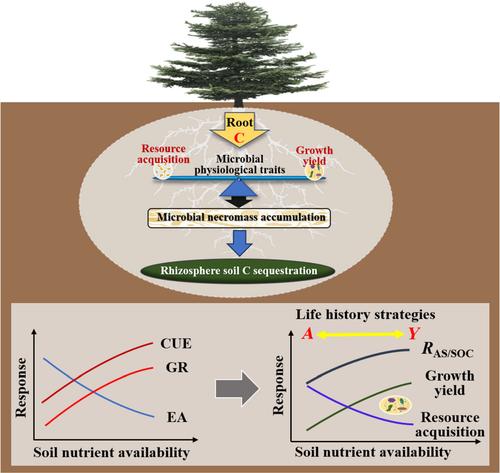Our official English website, www.x-mol.net, welcomes your
feedback! (Note: you will need to create a separate account there.)
Rhizosphere as a hotspot for microbial necromass deposition into the soil carbon pool
Journal of Ecology ( IF 5.3 ) Pub Date : 2024-11-15 , DOI: 10.1111/1365-2745.14448 Qitong Wang, Junxiang Ding, Ziliang Zhang, Chao Liang, Hans Lambers, Biao Zhu, Dungang Wang, Jipeng Wang, Peipei Zhang, Na Li, Huajun Yin
Microbial leftovers, known as necromass, are key players in storing carbon in the soil around plant roots (i.e. rhizosphere), a zone characterized by high‐efficiency microbial anabolism. Yet, the extent and mechanisms through which the rhizosphere contributes to soil organic carbon (SOC) via microbial necromass, especially under changing environments remain unclear. We aimed to evaluate the contributions of microbial necromass to SOC and influencing factors from the rhizosphere perspective. We collected the rhizosphere and bulk soil from 39 alpine coniferous forest sites on the eastern Tibetan Plateau to assess the extent of microbial necromass contribution to SOC in the rhizosphere from a dynamic perspective by calculating the ratio of increased amino sugars (AS) to increased SOC in the rhizosphere relative to that in bulk soil (R AS/SOC ). We also collected climate data and determined nutrient concentrations and microbial physiological traits in rhizosphere soil to elucidate the factors affecting R AS/SOC . The results showed that across all sampling sites, the average concentrations of SOC‐normalized AS in the rhizosphere were significantly higher than those in the bulk soil. Furthermore, the average R AS/SOC was greater than 1, indicating a faster microbial necromass accumulation than SOC accumulation in the rhizosphere. These results implied that the rhizosphere sustains a greater capacity for microbial necromass contribution to the SOC pool than the bulk soil does. Soil nutrient availability was the primary factor affecting R AS/SOC , and precipitation indirectly affected microbial anabolism and R AS/SOC by changing soil nutrient status. Additionally, with increasing rhizosphere soil nutrient availability, microbial carbon‐use efficiency and growth rate increased but the biomass‐specific enzyme activity declined, indicating that microorganisms tended to exhibit high‐yield strategies with increasing soil nutrient availability. Synthesis . Our findings underpin the vital effect of microbial necromass in SOC accumulation from the rhizosphere perspective and offer valuable insights into mechanisms underlying microbial C metabolic processes in rhizosphere SOC accumulation under changing environments.
中文翻译:

根际是微生物坏死物质沉积到土壤碳库中的热点
微生物残留物,称为坏死物质,是在植物根系(即根际)周围土壤中储存碳的关键因素,该区域的特点是高效微生物合成代谢。然而,根际通过微生物坏死量对土壤有机碳 (SOC) 的贡献程度和机制仍不清楚,尤其是在不断变化的环境中。我们旨在从根际的角度评估微生物坏死量对 SOC 的贡献和影响因素。我们从青藏高原东部的 39 个高寒针叶林地点收集了根际和块状土壤,通过计算根际氨基酸 (AS) 增加与 SOC 增加的比率,从动力学角度评估根际微生物坏死质量对根际 SOC 的贡献程度相对于散装土壤 (RAS/SOC)。我们还收集了气候数据,并确定了根际土壤中的养分浓度和微生物生理特性,以阐明影响 RAS/SOC 的因素。结果表明,在所有采样点中,根际 SOC 归一化 AS 的平均浓度显著高于大块土壤中的浓度。此外,平均 RAS/SOC 大于 1,表明根际微生物坏死量积累比 SOC 积累更快。这些结果表明,与大块土壤相比,根际维持着更大的微生物坏死质量对 SOC 池的贡献能力。土壤养分有效性是影响 RAS/SOC 的主要因素,降水通过改变土壤养分状况间接影响微生物合成代谢和 RAS/SOC。 此外,随着根际土壤养分可用性的增加,微生物碳利用效率和生长速率增加,但生物质特异性酶活性下降,表明微生物倾向于表现出高产策略,土壤养分有效性增加。合成。我们的研究结果从根际的角度支持了微生物坏死量在 SOC 积累中的重要影响,并为在变化的环境中根际 SOC 积累中微生物 C 代谢过程的机制提供了有价值的见解。
更新日期:2024-11-15
Journal of Ecology ( IF 5.3 ) Pub Date : 2024-11-15 , DOI: 10.1111/1365-2745.14448 Qitong Wang, Junxiang Ding, Ziliang Zhang, Chao Liang, Hans Lambers, Biao Zhu, Dungang Wang, Jipeng Wang, Peipei Zhang, Na Li, Huajun Yin

|
中文翻译:

根际是微生物坏死物质沉积到土壤碳库中的热点
微生物残留物,称为坏死物质,是在植物根系(即根际)周围土壤中储存碳的关键因素,该区域的特点是高效微生物合成代谢。然而,根际通过微生物坏死量对土壤有机碳 (SOC) 的贡献程度和机制仍不清楚,尤其是在不断变化的环境中。我们旨在从根际的角度评估微生物坏死量对 SOC 的贡献和影响因素。我们从青藏高原东部的 39 个高寒针叶林地点收集了根际和块状土壤,通过计算根际氨基酸 (AS) 增加与 SOC 增加的比率,从动力学角度评估根际微生物坏死质量对根际 SOC 的贡献程度相对于散装土壤 (RAS/SOC)。我们还收集了气候数据,并确定了根际土壤中的养分浓度和微生物生理特性,以阐明影响 RAS/SOC 的因素。结果表明,在所有采样点中,根际 SOC 归一化 AS 的平均浓度显著高于大块土壤中的浓度。此外,平均 RAS/SOC 大于 1,表明根际微生物坏死量积累比 SOC 积累更快。这些结果表明,与大块土壤相比,根际维持着更大的微生物坏死质量对 SOC 池的贡献能力。土壤养分有效性是影响 RAS/SOC 的主要因素,降水通过改变土壤养分状况间接影响微生物合成代谢和 RAS/SOC。 此外,随着根际土壤养分可用性的增加,微生物碳利用效率和生长速率增加,但生物质特异性酶活性下降,表明微生物倾向于表现出高产策略,土壤养分有效性增加。合成。我们的研究结果从根际的角度支持了微生物坏死量在 SOC 积累中的重要影响,并为在变化的环境中根际 SOC 积累中微生物 C 代谢过程的机制提供了有价值的见解。


















































 京公网安备 11010802027423号
京公网安备 11010802027423号